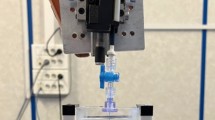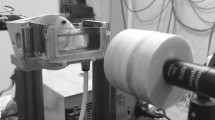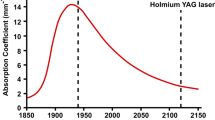Abstract
Purpose
A superpulse (500 W peak power) thulium fiber laser operating at a 1940 nm wavelength, suitable for lithotripsy, has recently been developed. The goal of this study was to compare stone fragmentation and dusting performance of the prototype superpulse thulium fiber laser with leading commercially available, high-power holmium:YAG lithotripters (wavelength 2100 nm) in a controlled in vitro environment.
Methods
Two experimental setups were designed for investigating stone ablation rates and retropulsion effects, respectively. In addition, the ablation setup enabled water temperature measurements during stone fragmentation in the laser–stone interaction zone. Human uric acid (UA) and calcium oxalate monohydrate (COM) stones were used for ablation experiments, whereas standard BegoStone phantoms were utilized in retropulsion experiments. The laser settings were matched in terms of pulse energy, pulse repetition rate, and average power.
Results
At equivalent settings, thulium fiber laser ablation rates were higher than those for holmium:YAG laser in both dusting mode (threefold for COM stones and 2.5-fold for UA stones) and fragmentation mode (twofold for UA stones). For single-pulse retropulsion experiments, the threshold for onset of stone retropulsion was two to four times higher for thulium fiber laser. The holmium:YAG laser generated significantly stronger retropulsion effects at equal pulse energies. The water temperature elevation near the laser-illuminated volume did not differ between the two lasers.
Conclusions
Distinctive features of the thulium fiber laser (optimal wavelength and long pulse duration) resulted in faster stone ablation and lower retropulsion in comparison to the holmium:YAG laser.


Similar content being viewed by others
References
Giusti G, Proietti S, Villa L et al (2016) Current standard technique for modern flexible ureteroscopy: tips and tricks. Eur Urol 70:188–194
Bell JR, James P, Rane A et al (2016) International Holmium laser lithotripsy settings: an international survey of endourologists. J Am Coll Surg 223:e123
Aldoukhi AH, Roberts WW, Hall TL et al (2017) Holmium laser lithotripsy in the new stone age: dust or bust? Front Surg 4:57. https://doi.org/10.3389/fsurg.2017.00057
Teichman JM, Vassar GJ, Bishoff JT et al (1998) Holmium: YAG lithotripsy yields smaller fragments than lithoclast, pulsed dye laser or electrohydraulic lithotripsy. J Urol 159:17–23
Larizgoitia I, Pons JM (1999) A systematic review of the clinical efficacy and effectiveness of the holmium: YAG laser in urology. BJU Int 84:1–9
Lam JS, Greene TD, Gupta M (2002) Treatment of proximal ureteral calculi: holmium: YAG laser ureterolithotripsy versus extracorporeal shock wave lithotripsy. J Urol 167:1972–1976
Sea J, Jonat LM, Chew BH et al (2012) Optimal power settings for Holmium:YAG lithotripsy. J Urol 187:914–919
Patel AP, Knudsen BE (2014) Optimizing use of the holmium: YAG laser for surgical management of urinary lithiasis. Curr Urol Rep 15(4):397. https://doi.org/10.1007/s11934-014-0397-2
Elhilali MM, Badaan S, Ibrahim A et al (2017) Use of the moses technology to improve holmium laser lithotripsy outcomes: a preclinical study. J Endourol 31:598–604
Yaroslavsky I, Vinnichenko V, McNeill T et al (2018) Optimization of a novel TFL lithotripter in terms of stone ablation efficiency and retropulsion reduction. Therapeutics and diagnostics in urology 2018. International society for optics and photonics 10468:104680H
Zamyatina V, Gapontsev V, Enikeev D et al (2016) Super pulse thulium fiber laser for lithotripsy. Lasers Surg Med 48:10 (Abstract)
Jackson SD, Lauto A (2002) Diode-pumped fibre lasers: a new clinical tool? Lasers Surg Med 30:184–190
Fried NM, Irby PB (2018) Advances in laser technology and fibre-optic delivery systems in lithotripsy. Nat Rev Urol 15:563–573
Blackmon RL, Irby PB, Fried NM (2011) Comparison of Holmium:YAG and Thulium fiber laser lithotripsy: ablation thresholds, ablation rates, and retropulsion effects. J Biomed Opt 16:071403
Ergakov D, Martov A, Guseynov M (2018) The comparative clinical study of Ho:YAG and superpulse TFL lithotripters. Europ Urol Suppl 17:e1391 (Abstract)
Martov A, Ergakov D, Guseinov M et al (2018) Initial experience in clinical application of thulium laser contact lithotripsy for transurethral treatment of urolithiasis. Urologiia Mar 1:112–120
Traxer O, Rapoport L, Tsarichenko D et al (2018) First clinical study on superpulse thulium fiber laser lithotripsy. J Urol 199:e321 (Abstract)
Hale GM, Querry MR (1973) Optical constants of water in the 200-nm to 200-μm wavelength region. Appl Opt 12:555–563
Hardy LA, Irby PB, Fried NM (2018) Scanning electron microscopy of real and artificial kidney stones before and after thulium fiber laser ablation in air and water. Therapeutics and diagnostics in urology. Int Soc Opt Photon 10468:104680G
Kronenberg P, Traxer O (2014) In vitro fragmentation efficiency of holmium: yttrium-aluminum-garnet (YAG) laser lithotripsy - a comprehensive study encompassing different frequencies, pulse energies, total power levels and laser fibre diameters. BJU Int 114:261–267
Vassar GJ, Teichman JM, Glickman RD (1998) Holmium:YAG lithotripsy efficiency varies with energy density. J. Urol 160:471–476
Wezel F, Hacker A, Gross AJ et al (2010) Effect of pulse energy, frequency, and length on holmium:yttrium–aluminum–garnet laser fragmentation efficiency in non-floating artificial urinary calculi. J Endourol 24:1135–1140
Pasqui F, Dubosq F, Tchala K et al (2004) Impact on active scope deflection and irrigation flow of all endoscopic working tools during flexible ureteroscopy. Eur Urol 45:58–64
Li R, Ruckle D, Keheila M et al (2017) High-frequency dusting versus conventional holmium laser lithotripsy for intrarenal and ureteral calculi. J Endourol 31:272–277
Hardy LA, Vinnichenko V, Fried NM (2019) High power holmium: YAG versus thulium fiber laser treatment of kidney stones in dusting mode: ablation rate and fragment size studies. Lasers Surg Med. https://doi.org/10.1002/lsm.23057
Greif R (1988) Natural circulation loops. J Heat Transf 110:1243–1258
Lee HO, Ryan RT, Teichman JM et al (2003) Stone retropulsion during holmium: YAG lithotripsy. J Urol 169:881–885
Author information
Authors and Affiliations
Contributions
VA: project development, data collection and management. AV: data collection, manuscript editing. IY: project development, data analysis, manuscript writing. AK: project development, data collection and management. AV: data analysis, manuscript editing. LR: data analysis, manuscript editing. DE: project development, data analysis, manuscript editing. NS: data analysis. AD: data analysis, manuscript editing. DT: data analysis. PG: data analysis. OT: data analysis, manuscript editing. NF: data analysis, manuscript writing and editing. GA: project development, data analysis, manuscript editing. VG: data analysis, manuscript editing.
Corresponding author
Ethics declarations
Conflict of interest
V Andreeva: employee of NTO “IRE-Polus”; A. Vinarov: no competing interests exist; I. Yaroslavsky: employee, stockholder of IPG Medical; A. Kovalenko: employee of NTO “IRE-Polus”; A. Vybornov: employee, stockholder of IPG Medical; L. Rapoport: no competing interests exist; D. Enikeev: no competing interests exist; N. Sorokin: no competing interests exist; A. Dymov: no competing interests exist; D. Tsarichenko: no competing interests exist; P. Glybochko: no competing interests exist; O. Traxer: consultant to IPG Medical; N. Fried: consultant to IPG Medical; G. Altshuler: employee, stockholder of IPG Medical; V. Gapontsev: founder, employee, stockholder of IPG Photonics.
Additional information
Publisher's Note
Springer Nature remains neutral with regard to jurisdictional claims in published maps and institutional affiliations.
Rights and permissions
About this article
Cite this article
Andreeva, V., Vinarov, A., Yaroslavsky, I. et al. Preclinical comparison of superpulse thulium fiber laser and a holmium:YAG laser for lithotripsy. World J Urol 38, 497–503 (2020). https://doi.org/10.1007/s00345-019-02785-9
Received:
Accepted:
Published:
Issue Date:
DOI: https://doi.org/10.1007/s00345-019-02785-9




